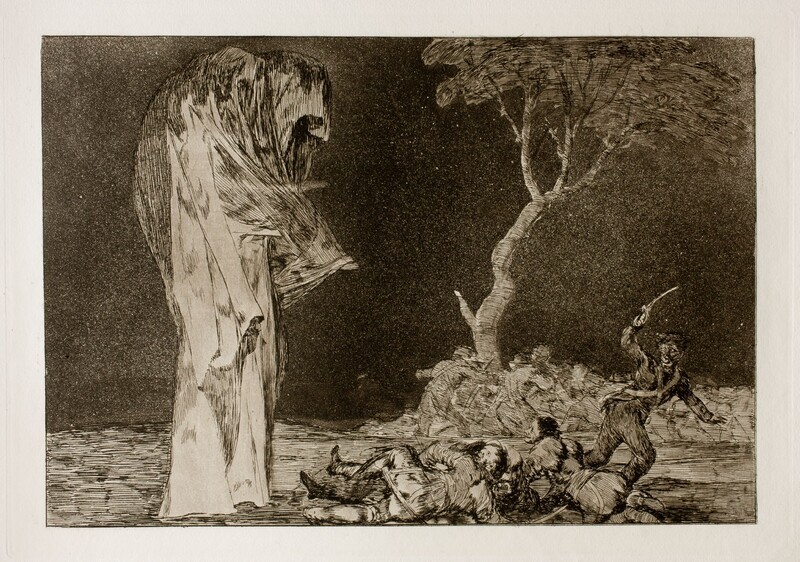- Cronología
- 1815 - 1819
- Dimensiones
- 245 x 357 mm
- Técnica y soporte
- Etching, burnished aquatint and drypoint
- Reconocimiento de la autoría de Goya
- Documented work
- Ficha: realización/revisión
- 20 Aug 2021 / 05 Jun 2023
- Inventario
- -
See Femenine folly.
In the Lazaro Galdiano Foundation in Madrid there is a state proof with the burnished aquatint in which the number 13 appears.
There are several proofs prior to the stripe affecting the figure of the ghost. This defect, which appeared around 1848 in a print eun prior to the first edition, was burnished to conceal it, without success.
Armed soldiers run in panic at the imposinf sight of a large, swollen ghost. On the right stands a gloomy tree with a teisted, dead trunk which, together with the horizon line,
forms the only landscape in the picture. The tree is a device that makes the viewer aware of the dimensions of the spectre, as it is as large as he is, or even slightly smaller, as the ghost appears hunched over, as if he did not fit into the frame of the picture.
At his feet, a group of French soldiers fall to the ground in terror. In the foreground, next to him, one of the soldiers is trying to get to his feet. Next to him, another kneeling companion has a look of horror on his face and, next to them, what appears to be the captain is running in terror with his sabre drawn, calling for a retreat. In the background, under the tree, a mass is gathered in fear. Only two soldiers can be made out, trying to get away from the ghostly being.
Various interpretations have been made of this scene. Most of them tend to be alonge the lines of Disasters (Sad presentiments of what is to happen), relating to the wartime sphere of the War of Independence. Thus, the ghost connects with the spectre of the condemnatory punishment of all armies for the evil they cause. It is also linked to the rebellion of the Spanish people against the Napoleonic army. . Finally, it may be a scarecrow, like the one in Caprice 52. What a Tailor Can, with which to frighten the troops and make them flee. In general, it can be said that the phantom embodies all the pain and evil caused by wars.
This print is notable for Goya's use of etching lines to create the forms and volumes. In the apparition, they are arranged in an angular manner to outline the drapery. The dark background of the aquatint reveals a nocturnal scene that accentuates the horror.
The preparatory drawing for the present print, also entitled Fearful folly, has survived.
The plate has a stripe at the top of the figure of the ghost that is reflected in the print.
-
Etchings by Francosco GoyaJohannesburgoJohannesburgo1974
-
Grabados de Goya: colección propiedad de la Biblioteca Nacional, que se conserva en su Gabinete deCasa de la Amistad de MoscúMoscow1979exhibition displayed from January 18th to 31st 1979
-
Goya. Das Zeitalter der Revolucionen. Kunst um 1800 (1980 – 1981)Hamburger KunsthalleHamburg1980cat. 147
-
Goya y el espíritu de la IlustraciónMuseo Nacional del PradoMadrid1988from October 6th to December 18th 1988. Exhibited also at Museum of Fine Arts, Boston, January 18th to March 26th 1989; The Metropolitan Museum of Art, Nueva York, May 9th to July 16th 1989, Madrid curator Manuela B. Mena Marqués, scientific directors Alfonso E. Pérez Sánchez and Eleanor A. Sayre
-
Ydioma universal: Goya en la Biblioteca NacionalBiblioteca NacionalMadrid1996from September 19th to December 15th 1996cat. 297
-
Francisco Goya. Sein leben im spiegel der graphik. Fuendetodos 1746-1828 Bordeaux. 1746-1996Galerie KornfeldBern1996from November 21st 1996 to January 1997
-
Goya. 250 AniversarioMuseo Nacional del PradoMadrid1996consultant editor Juan J. Luna. From March 29th to June 2nd 1996
-
Goya grabadorMuseo del Grabado Español ContemporáneoMarbella1996from March 8th to May 5th 1996
-
Zaragoza1996
-
London1997
-
Madrid1999
-
Schlaf der Vernunft. Original radierungen von Francisco de GoyaMunich2000
-
Bilbao2012
-
Goya et la modernitéPinacothèque de ParisParís2013from October 11st 2013 to March 16th 2014cat. 202
-
Goya: Order and disorderMuseum of Fine ArtsBoston2014cat. 236
-
OxfordBruno Cassirer1964pp. 374-375, cat. 249
-
Vie et ouvre de Francisco de GoyaParísOffice du livre1970p. 325, cat. 1573
-
Catálogo de las estampas de Goya en la Biblioteca NacionalMadridMinisterio de Educación y Cultura, Biblioteca Nacional1996p. 235, cat. 375-376
-
MadridReal Academia de Bellas Artes de San Fernando y Calcografía Nacional1996pp. 101 y 109, cat. 2 y 22
-
ParísPinacoteca de París2013p. 270
-
Goya: Order & DisorderBostonMuseum of Fine Arts Boston Publications2014pp. 337-340
-
Goya. In the Norton Simon MuseumPasadenaNorton Simon Museum2016pp. 204-211

